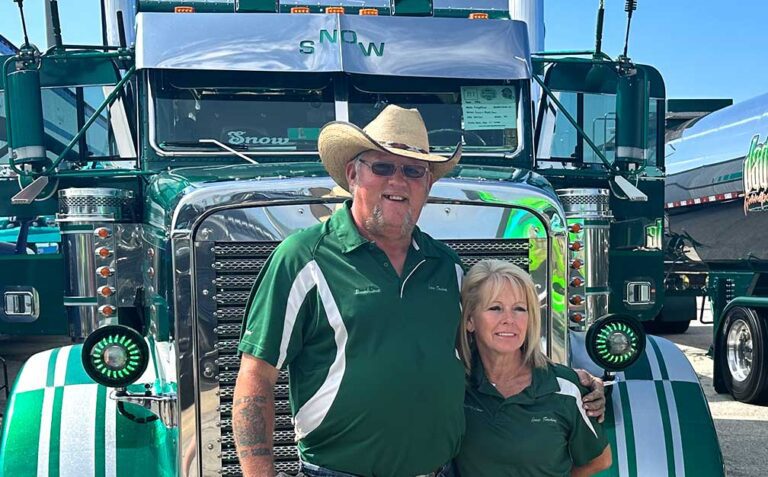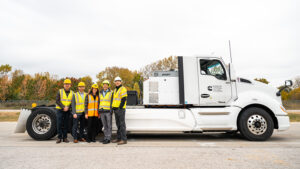Truckers are known to be independent people, capable of accomplishing their work without constant oversight. A professional trucker’s co-workers are often other drivers that are seen only occasionally, perhaps at safety meetings, or when paths cross at a truck stop.
For many drivers, that’s just fine. However, not every driver is a fan of the solitude that comes with working solo. Some drivers prefer the teamwork and companionship of a team operation.
While there are many benefits to team driving, the practice does bring its own set of problems.
Even the best of friends — or closest of couples — can be susceptible to the irritants that come with sharing the small area of a truck cab and sleeper with another person. Privacy can be hard to come by. Simple decisions, like when to stop for meals or restroom breaks, can go from a simple necessity to cause for disagreement. In addition, as a team driver, your work records are often dependent on the performance of another person.
There are many reasons people choose to drive as a part of a team.
Couples often team up in the truck as they have in life, sharing their highway experiences while maximizing their income potential. Teaming up can be a rewarding experience and can help couples earn quickly to fund a home purchase or fill a retirement account.
Some newer drivers earn their trucking “chops” by working with a more experienced relative. Many first experience team driving as a part of a “driver finishing” program, where new hires are paired with a trainer as they learn the trade. Some carriers also require newer drivers to team with another driver of the same experience level for a period of time before going solo.
If you’re considering a team driving job, there are a few things to keep in mind. Choosing the right person, setting the ground rules and working together to maintain the relationship can make team driving a rewarding experience for both drivers.
Who’s your partner?
The first consideration is who you’ll partner with. Personalities matter, so if you’re planning to team with someone you know, consider how that person handles adversity. If that person angers easily or is prone to violence, don’t assume that aggression will never be directed towards you. Even the closest of relationships can crack when two people live in such close proximity.
Division of duties
Before hitting the road together, it’s a good idea to have a serious discussion about division of duties.
While each driver should be able to perform all the tasks of a professional driver, every person has preferences, and each driver’s abilities to perform different duties may be different.
Some tasks, such as pre-trip inspections and fueling, should be done by the driver who’s on duty at the time. In some teams, however, one person may handle meal preparation or paperwork, while another focuses on vehicle maintenance or route planning. It’s best that both partners have a clear understanding of who does what, before problems arise.
Clear the air
Even the best of relationships can deteriorate quickly on the road, so it’s important for team members to set some parameters up front and have frequent discussions to monitor progress and air out any issues while they’re small.
If one driver has much more experience than the other, it’s important to respect the newer driver’s dignity when explaining tasks. No one likes to be “corrected” by a peer.
When disputes arise — and they will — teams need a way to work them out. Timing is important. For example, an in-depth, emotional discussion shouldn’t take place while one driver is negotiating city traffic. Teammates can “agree to disagree” until a more appropriate time.
Discussions should be approached rationally, keeping Stephen Covey’s habit of “think win-win” in mind. Try to find solutions that are satisfactory to both team members rather than trying to “win” the argument.
Be aware of irritants that occur at any time. A traffic near-miss, a disagreement with dispatch, a conversation with a law enforcement officer — any of these can create a mood that isn’t great for a discussion. Sometimes it’s best to wait for a better moment, when both participants are in a talking frame of mind.
Respect for privacy
Privacy is an issue with every driving team. While the bunk area provides at least a bit of privacy, it’s painfully evident that team members are separated only by a curtain.
One technique some teams use to increase privacy is to go different ways at the truck stop, setting a time to meet back at the truck. For example, one driver might visit the restaurant and C-store while the other is showering. Doing so provides some “me time” for each team member.
Respecting the curtain is something both drivers must agree on. When the non-driving partner is in the bunk, it’s their choice whether to interact. The curtain might be left open, for example, while reading or watching television, but pulled shut when privacy is desired for dressing, making a phone call or other activities. The best rule is that when the curtain is closed, the person in the bunk is left alone.
To help avoid unfortunate incidents, such as one driver taking off from a truck stop or shipper, assuming the other driver is in the sleeper area because the curtain is drawn, some teams institute a “shoes” rule. When the team partner is in the bunk, their shoes are left on the floorboard in front of the seat. If the shoes are missing, the other driver doesn’t move the truck.
Other stuff to consider
Even when a team works well together with minimal issues, for company drivers, the carrier can have a huge impact on the success of the team. Some carriers accept teams but don’t really have the freight mix to get them the miles they need.
If your team is trying to maximize income, dispatched loads need to provide twice the miles of typical solo runs. You’ll want runs that provide 1,000 paid miles or more per day. For some team members, however, the shared experience is more important and fewer miles aren’t an issue. Discuss your mileage, as well as your time-off needs with your carrier.
Also, we’ve got a word of warning for the ladies, or really, any driver: If your team partner becomes abusive verbally or physically, get off the truck at the nearest safe opportunity. You may choose to work out the driving relationship later, in a safer environment. Staying on the truck when you feel threatened could be a dangerous decision.
Cliff Abbott is an experienced commercial vehicle driver and owner-operator who still holds a CDL in his home state of Alabama. In nearly 40 years in trucking, he’s been an instructor and trainer and has managed safety and recruiting operations for several carriers. Having never lost his love of the road, Cliff has written a book and hundreds of songs and has been writing for The Trucker for more than a decade.














